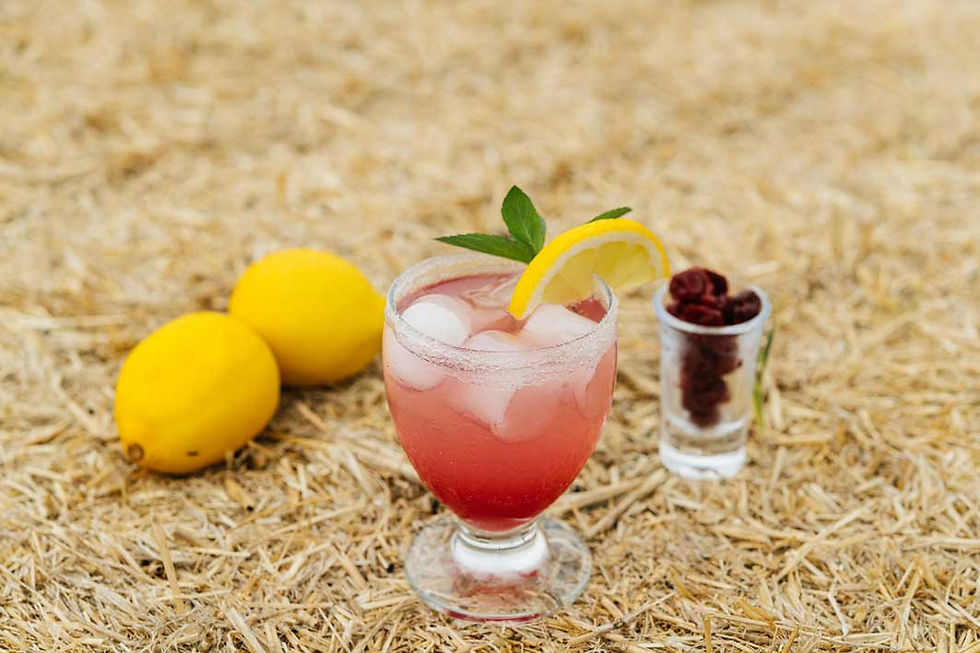Albertans are experts at drawing out summer as long as possible. We might be clinging to warm weather and the outdoors a little bit harder this year, in denial of the fact that the days are getting shorter. But, as the season winds down, we’re moving right into the beginning of harvest season, and fruit that has ripened on branches and vines is bursting with deep flavour, while golden honey drips like a late summer sunset.
In the spirit of holding on to our summer for a bit longer, we’ve sought out fruit gardens, honey farms, and wineries in Alberta to bring you those last tastes of this sweet season and learn a little more about the raw ingredients that are grown and
used at these businesses and how to incorporate them into your kitchens at home.

For more than a decade Hugo and Ilse Bonjean at Spirit Hills Winery, near Millarville, have been producing food-pairing wines that come from the terroir of the Rocky Mountain Foothills. “What we do is pretty unique in the world,” says co-owner and president Hugo Bonjean. “Just like people know different grapes produce different wines, so do different flowers produce different nectars. That in turn creates different wines.”
Wildflower nectar is collected, dried, and stored as honey by Spirit Hills’ bees. Full of antioxidants, raw honey is a sterile product, which can’t be fermented. “What we do when we make wine is we rehydrate the honey, turning it back into its liquid nectar state and that is what gets fermented,” explains Bonjean. The fermented nectar is then infused with a variety of hand-picked wildflower petals for white and rosé varieties. For red wine blackcurrants are macerated in the tanks throughout the fermentation period.

“Blackcurrants are one of the berries with the highest amount of antioxidants,” says Bonjean. They also contain anthocyanins – the compound in grape skins that gives red wine its colour and flavour – but at a concentration 30 to 90 times higher, making currants an ideal replacement for grapes when making wine. They also make for delicious desserts.
Find the recipe for The Bonjeans' Blackcurrant Ice Cream Parfait here.

At DNA Gardens in Elnora, Red Seal Chef Lynsey Armstrong has her pick of fresh ingredients grown right on site, from herbs and edible flowers to a variety of fruit, like saskatoons, raspberries, and sour cherries. DNA Gardens also works with local ranchers and craft breweries to bring a unique experience to their visitors. “Every evening during the summer we have a Bootlegger, Beer and Brisket Dinner, where we have a delicious meal with slow smoked brisket, followed by saskatoon pie and gelato,” explains Armstrong.
DNA Gardens also produces jams, jellies, and syrups that are available for purchase both at the gardens and Gasoline Alley in Red Deer. “Our jams contain only 25% of the sugar of [commercially produced] jams,” says Armstrong. “We use a different pectin that allows us to reduce our sugar which results in a flavour bang of fruit.”

For Armstrong’s Tart Cherry Lemonade, fresh cherries are best, and visitors can pick them in season at the gardens. “When you harvest and pit your own cherries, put your cherries in the fridge overnight and pit them when ice cold,” Armstrong recommends. “They will make a lot less mess and you will retain more juice.”
Find the recipe for Lynsey Armstrong's Tart Cherry Lemonade here.

Forty-two percent of Canada’s honey is produced in Alberta, and at Chinook Honey Company in Okotoks, owners and operators Art and Cherie Andrews have had sweet success in the industry since 1995, when they started with just two hives. Since then, they’ve grown and added education and tourism components. “The thing we really appreciate about this business model is being able to work directly with the customer, and get to know their needs,” explains Cherie.
Along with jams, jellies, sauces, and mead, produced and sold on site, the honey itself is sold in many shapes and forms, says Cherie. “If you’re looking for a good honey product, try and buy from a local producer,” she advises, and turn the container upside down and look for a large air bubble to slowly make its way to the top – this will usually tell you if the honey is pure, or has been watered down.

While it’s often enjoyed drizzled on fresh bread, or even by the spoonful, Art says honey can be used as a substitute for sugar in most dishes, in half the amount that sugar is called for. “A little-known fact about honey is its relatively high acidity,” he adds. With a pH level of about 4, it works well as a substitute for vinegar, and in meat marinades like this recipe for Honey Whisky Sirloin.
Find the recipe for the Andrews' Honey Whisky Sirloin here.

Comments